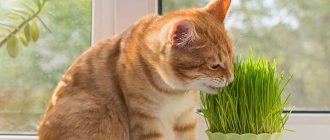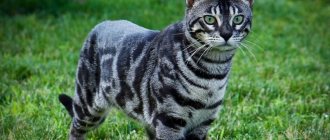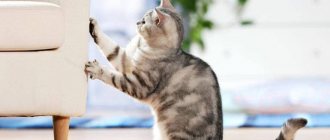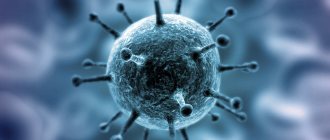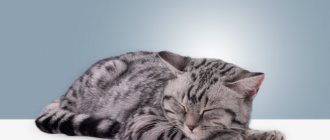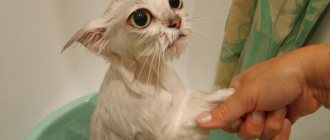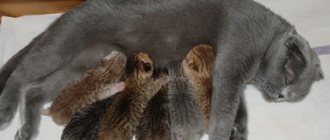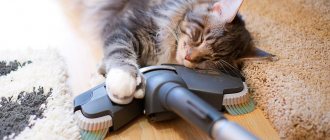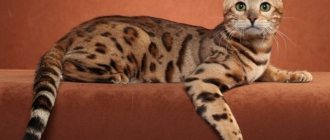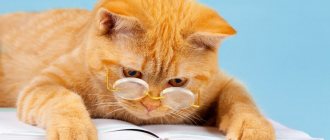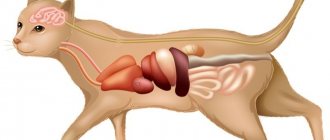Respiratory system
The task of the respiratory organs is to ensure gas exchange and deliver oxygen to the tissues. The process of releasing excess moisture also goes through them. The respiratory system participates in heat exchange and removes excess heat and harmful gases.
Respiratory organs of a cat:
- nose;
- nasopharynx;
- bronchi;
- trachea;
- lungs.
Bengals and other breeds weigh up to 6 kg, the Maine Coon can weigh up to 13 kg
The nasal cavity is surrounded by mucous membrane, which performs the function of smell. Thanks to the villi on the epithelium, the nose serves as a filter that cleans the incoming air from dust and dirt. The larynx has vocal cords that allow the animal to meow.
A cat's lungs are made up of many alveoli. The left lung is slightly larger in volume than the right (8 and 11 cm3, respectively).
Cat - description and photo.
The fluffy, purring, caressing four-legged creature is a real predator, despite its cute and cute appearance. Under normal conditions, cats feed on small birds; especially brave representatives of the cat family even attack. This animal hunts in a typical way for all cats: in the event of a successful attack, it grabs the prey by the neck and bites between the vertebrae, gnawing the nerve. Pets have undoubted advantages: not to mention milk and fish, there are even specialized foods for cats. However, the owner of the animal needs to keep in mind that the normal weight of most cat breeds ranges from 2.5 to 6.5 kg. More weight clearly indicates obesity.
Digestive system
Cat skeleton: anatomy, skull, structure
The cat's insides form the digestive system, which is responsible for taking in food, processing and eliminating undigested residues. A cat’s body processes food within a day.
Participating in this process are:
- oral cavity;
- pharynx;
- esophagus;
- stomach;
- small and large intestines;
- kidneys and liver.
A cat's stomach is more acidic than a human's, so it can process rough food. The structure of a cat's intestines does not allow it to digest carbohydrates well. This must be taken into account when planning your diet.
Digestive organs
Digestion begins as soon as the food enters the oral cavity. Saliva softens food and promotes quick chewing. Then the food passes through the pharynx and esophagus into the stomach. There, the active breakdown of foods into liquid, carbohydrates, proteins and fats begins. The contents then pass into the duodenum and small intestine. Unprocessed residues form feces and pass through the rectum.
Interesting! The pet's stomach is in constant activity.
This is why animals often eat, but little by little.
Internal structure of a domestic cat
Representatives of the cat family are mammals, so the structure of the internal organs of a cat is practically no different from similar structures of other creatures included in this class. The systems and organs of these animals work according to principles characteristic of most mammals and perform similar functions. However, there are features that are unique to cats. The internal structure of a cat can be seen in the photo, and a description of the most important systems is presented below.
Internal organs of a cat
The cardiovascular system
The cardiovascular system is formed by a network of blood vessels and the heart, which ensures the movement of blood cells and lymph. The main function of this system is to saturate tissues with nutrients and oxygen, as well as remove waste products.
The heart is a special muscle in a cat's body. It has 4 chambers: 2 atria and 2 ventricles. In an adult cat, the weight of the heart is about 15–30 g. The ventricles of the heart contract and force the blood to move through the vessels.
Large blood vessels - veins and arteries - carry blood away from the heart and return it back. Small vessels are capillaries that deliver blood to the organs. Thanks to them, tissues are saturated with oxygen and nutrients. Blood consists of blood cells (red blood cells, platelets and white blood cells) and plasma.
Digestive organs
The digestive system includes the oral cavity (tongue, teeth, salivary glands), pharynx, esophagus, stomach and pancreas, liver, gall bladder and intestines, which includes 4 sections: duodenum, small intestine, ileum and large intestine. The esophagus starts from the base of the mouth and connects to the stomach, the inner surface of which is formed by many folds. They increase the mechanical effect on food masses during digestion.
The food then passes through the pyloric sphincter and enters the duodenum. Here the food is mixed with pancreatic and liver enzymes. The digestion process continues.
In the small intestine, all nutrients are absorbed thanks to the many villi lining the inner surface of the intestine. The mass then turns into feces, passing through the ileum and colon, where excess moisture is sucked out of it.
Central and peripheral nervous system
The nervous system of cats consists of central and peripheral parts. The central nervous system includes the brain, spinal cord and brain stem. This part is responsible for reflex actions, behavior and reactions to external stimuli.
Anatomy of a cat's nervous system
The peripheral section ensures the regulation of conscious movements. The ability of cats to move, groom themselves, hide and extend their claws, and perform all conscious actions depends on the operation of this system.
The central and peripheral sections are interconnected. Impulses from parts of the body enter the brain, which sends response signals.
Respiratory system
The respiratory system is designed for gas exchange processes. The respiratory organs saturate the body with oxygen and remove carbon dioxide. Normally, cats breathe quite frequently. In 60 seconds, a cat can take up to 100 breaths. The respiratory system includes:
The main respiratory organ is the lungs. The lung located on the left has an additional lobe, so its size is slightly larger. Through the alveoli, oxygen enters the bloodstream, and carbon dioxide exits.
Reproductive organs
The genitals perform a reproductive function. Kittens reach sexual maturity and readiness for breeding at 8–11 months. During this period, their behavior changes, cats begin to look for a partner for mating. The females have their first heat. The reproductive organs of a cat include the ovaries, bicornuate uterus, fallopian tubes, cervix, vulva and vagina. The ovaries ensure that the female’s body is ready for pregnancy and bearing offspring. Fertilized eggs mature in the horns of the uterus.
The male reproductive system includes the prostate, testes, scrotum, vas deferens and penis. Sperm mature in the testes and testosterone is produced. The seminal fluid comes out through the ducts.
Endocrine system
The function of the endocrine system is to produce hormones and maintain their normal levels in the blood. Hormones regulate many processes occurring in the body. Most hormones are produced by the hypothalamus and pituitary gland, which are located in the brain. In this part of the endocrine system, cortisol, antidiuretic, follicle-stimulating, adrenocorticotropic hormone, oxytocin, and corticoliberin are released.
Hormones are also produced in the adrenal glands, thyroid gland and ovaries. The adrenal glands produce cortisol, which is formed in the cortex of this organ. Cortisol takes part in the regulation of metabolic processes. The adrenal medulla also produces important hormones - adrenaline and norepinephrine. These substances influence the pulse rate and regulate the constriction of blood vessels.
Sex hormones - estrogen and progesterone - are produced in the ovaries. They are responsible for the behavior of cats during the mating period, promote pregnancy in females, prepare the body for conception, and participate in the development of the egg.
Urinary system
The feline excretory system includes the kidneys, ureters, bladder and urethra. The kidneys are located behind the intestines. This is where the process of urine formation begins. The processed fluid passes through the ureters and enters the cavity of the bladder, from where it is discharged out through the urethra.
The urinary system ensures the removal of waste products from the body. The kidneys regulate water-salt balance and are responsible for the formation of hormones such as renin and erythropoietin. These substances are involved in the process of hematopoiesis and regulation of pressure in blood vessels.
Reproductive system of cats
Bad breath from a cat: causes of the disease and what can be done
The internal structure of a cat and a tom differ in the reproductive system. The cat's genitals provide the formation and transfer of seminal fluid, which includes sperm.
Diagram of the male reproductive system:
- prostate;
- vas deferens;
- scrotum;
- penis;
- testes.
The testes produce sperm and produce testosterone. Sperm is produced throughout the cat's life, or until castration.
Body parts and body systems
The system responsible for procreation is important for any animal. In addition to its main task, it produces hormones that are necessary for the development of the body. The genital organs of males and females are different, however, they have a common structural principle. For example, the production of germ cells is possible thanks to paired sex glands: ovaries in cats and testes in cats. The cells produced in the glands travel along the reproductive ducts: oviducts in females, vas deferens in males.
Sense organs
They help the animal perceive and learn about the world around it.
There are five categories of feelings:
- vision;
- hearing;
- touch;
- taste;
- sense of smell.
Each organ has a receptor, an analyzer and a conductor. The information that the receptors receive goes through conductors (nerve endings) to the analyzer brain.
Internal and external genitalia of a cat
The reproductive system of a female cat consists of the following organs:
- ovaries;
- the fallopian tubes;
- uterus;
- vagina;
- vestibule of the vagina;
- external genitalia.
The cat has bleeding on the second day after giving birth
The ovaries are a paired organ located in the lumbar region. This organ is responsible for the formation of hormones and the maturation of germ cells. Pets regularly ovulate, which allows them to become pregnant.
Important! If the owner does not plan to breed cats, then it is advisable to sterilize the cat. Otherwise, hormonal imbalances, tumor development, cystitis and other diseases are possible.
The fertilization process takes place in the fallopian tubes, after which the egg passes into the uterus. The uterus is a hollow organ that consists of a cervix, body and horns. The vagina is an organ that connects the cervix and the external genitalia. At the onset of puberty, the cat's ovaries increase in size.
The structure of the reproductive system of cats
The vulva serves as the external organ of the reproductive system in cats. It is located below the anus.
Anatomy of cats in pictures
For example, the cervical region is responsible for movements made by the head; in cats it has great elasticity, so the angle of rotation is almost equal to 180 degrees. Next comes the thoracic region, which consists of 12 pairs of ribs that form the chest. The movements of the hind legs depend on the lumbar region, thanks to which cats can jump. The caudal region contains the largest number of vertebrae, which make up the animal's tail.
Cat limbs also have a rather complicated structure. Many have heard stories where a cat fell from a great height, but survived by falling on its paws. During flight, these animals are capable of turning over very quickly, in order to then fall on their paws.
Scull
Cats have the smallest skulls among other pets. It contains eleven bones, and the front part consists of thirteen bones. The bones of the skull are very strong, so they reliably protect the cat’s brain from various types of damage.
Muscles
The cat's muscular system includes about five hundred muscles, thanks to which the animal has elegance and flexibility. Cat muscles have a complex structure and amazing elasticity, which allows pets to run fast and jump high. Each muscle includes two parts responsible for performing different functions: work and support. In addition, muscles have nerve connections and blood vessels. Another muscle function is to maintain the skeleton in the correct position.
Cardiovascular system and heart
The cardiovascular system is one of the main ones in the animal’s body. It is responsible for vital processes, transports blood throughout the body and saturates tissues with oxygen.
Circulatory system
The anatomical structure of the blood of cats differs from other animals. It cannot be supplemented or replaced. Red blood cells, which are part of the blood, provide the body's organs with oxygen. As blood passes through the body, it travels through the right ventricle and into the pulmonary artery. Oxygenated blood returns to the left side of the atrium and then to the ventricle. In total, cats have 2 circles of blood circulation.
Interesting! The weight of the heart depends on the weight of the pet and usually accounts for 0.6% of the total figure.
Cat skin and fur
The skin protects the animal’s body from external factors: radiation, microorganisms, chemical and mechanical damage. Wool also plays a protective function, but in addition it is responsible for temperature regulation of the body. Often, it is the quality and appearance of the coat that most eloquently indicates the health of the cat.
The epidermis is the outermost layer of the skin and performs a protective function. It is what protects the body from external factors. Essentially, the epidermis is dead skin cells that act as a barrier. Beneath them there are several layers of “living” cells - the basal layer. Next is the dermis, which contains capillaries, nerves, sebaceous glands and hair follicles.
The sebaceous glands produce oil, which makes the coat shiny. Glands located on the muzzle secrete a secretion that has a special smell and is used by cats to mark their territory. Between the fingers and near the anus there are also sebaceous glands that produce sex pheromone.
Each hair consists of cuticular cells that are layered on top of each other. From one follicle up to 6 guard hairs can grow, which are surrounded by soft and thin down. These fine hairs form a warm undercoat. Each follicle can lift hairs upward with the help of special muscles. Thanks to them, in case of danger, the cat's fur stands on end. A cat has whiskers or whiskers on its head. They perform a tactile function. The same shorter hairs grow throughout the animal's body.
urinary system
When studying the structure of a cat, internal organs and their functions, it is worth noting the urinary system. It consists of the following organs:
- kidneys;
- ureters;
- bladder;
- urethra.
The kidneys are a paired organ located on the right and left in the lumbar region. They perform the following functions:
- regulate blood volume and extracellular fluid;
- control ionic balance in the body;
- stabilize the acid level in the blood;
- participate in blood clotting and blood pressure regulation;
- remove excess metabolic products from the body;
- regulate metabolism.
First, primary urine is formed, which contains glucose, vitamins and amino acids. It then passes through the convoluted canals and accumulates in the renal pelvis. From this point on, urine is considered secondary. It enters the ureters and bladder. As a result, urine comes out through the urethra. Spontaneous leakage is facilitated by a muscular organ - the sphincter.
Important! In healthy animals, urine has virtually no color. If it turns orange or brown, this may indicate urolithiasis.
In cats, the urethra is wider and shorter than in cats. Because of this feature, females are less likely to experience urinary problems.
Muscular system
Cats have an unusually developed muscular system. This is proven by their amazing jumps over fairly long distances and fast running. Also, a set of muscles helps the cat maintain its aristocratic bearing.
Thanks to its developed muscular system, a cat is able to perform amazing movements.
In total, a cat has about 500 muscles. They can be divided into 3 categories:
- heart muscle;
- smooth muscles, which control internal organs and work involuntarily;
- striated muscles that the cat controls itself.
Special fibers are part of all muscles. Cat muscles contain 3 types of cells:
- are strongly contracted, but work for a short time - thanks to them, the cat is able to jump long distances; the strength of these cells is not able to act for long;
- with a strong contraction they work for a long time - a cat has few such cells, which explains its inability to run long distances;
- they contract quietly and work for a long time - this type of muscle cells is used in a cat when hunting, when it sits in ambush for a long time, and also sneaks quietly and gently.
When hunting, a cat uses muscle cells that can work for a long time
The structure of the shoulder girdle has a peculiarity: the muscles connect the forelimbs and the torso, while in humans they are connected by the collarbone. In cats it is in its infancy.
To take a step, the cat pushes off with its hind paws, and the front paws participate in the braking process. Thanks to the elasticity of the back muscles, the cat can easily curl into a ball and assume other bizarre poses.
Endocrine system
The endocrine system is responsible for the production of hormones that are carried throughout the body through the blood. Thus, the activity of the body is monitored. Hormones can make organs work faster or vice versa - slower.
The amount of hormones in the blood is constantly monitored and adjusted to always meet the body's needs.
In textbooks and atlases you can find the following division of the endocrine system:
- glandular;
- diffuse.
The glandular system includes:
- hypothalamus;
- pituitary;
- pineal gland;
- thyroid;
- thymus;
- adrenal glands;
- gonads.
Interesting! The diffuse system is scattered throughout the body, but accumulates most in the gastrointestinal tract.
Nervous system
The nervous system of cats consists of the following organs:
- brain;
- spinal cord;
- nerve trunks and endings.
Nervous activity is carried out through the senses. Under the skin there are many nerve endings that can change your pet's behavior. This system is closely related to hormones, so it quickly responds to internal and external events.
To understand how a cat and its nervous system works, it is necessary to study the classification. This part of the body is usually divided into 2 classes: central and peripheral. The first consists of the brain and spinal cord. With their help, nerve impulses are carried out in the body. The peripheral nervous system receives information about pain, pressure, touch, and also transmits commands to the muscles.
External structure of a cat
The anatomical structure of a cat is incredibly organic and cannot but please the eye. Small size, cute face, soft paws, long flexible tail, fluffy fur - all this distinguishes cats from other animals. All parts of the body of these animals have their own charm and practical purpose, but at the same time they can hide certain secrets. For example, paws at first glance are completely harmless, but they hide the main weapon - the ability to release claws. Just like the cat itself, a seemingly affectionate pet, but at the same time a real predator.
Cat head
Eyes
The structure of a cat’s eye differs little from that of a human and a cat sees according to the same principle as we do – it reacts to light. The pupil tends to increase or decrease with the help of a special muscle, and its size depends on the amount of light. In the dark, a cat sees with the help of a special layer of the choroid - tapetum. It serves as a mirror that reflects the light received by the eyes, and due to this, vision is sharpened. The tapetum is also the reason why a cat's eyes glow in the dark.
Ears
The structure of a cat's ear allows it to detect more than 100 sounds, including ultrasonic sounds, with the help of which cats communicate with kittens. The auditory canals also contain an incredible number of nerve endings and more than 10 muscles. This is why cats can change the position of their ears on their heads - press them down, bend them, turn them towards the sound, etc.
Language
The structure of a cat's tongue is of some interest, primarily due to the fact that the animal manages to drink only with its help. The tongue is long, very flexible and, unlike, for example, a dog’s, very rough. The “sandpaper” effect occurs due to the keratinized papillae, which help retain food and also act as a kind of brush for cleaning the fur. In addition, the tongue performs a function that is familiar to us - recognizing the tastes of food. A cat can taste salty, bitter, sweet and sour.
Jaws and teeth
The structure of teeth in cats is of great importance, since teeth are one of the most important tools for hunting or, conversely, protection. An adult cat has 30 teeth, which are symmetrically located on the upper and lower jaw. The main tool for catching prey is 4 canines - these are the longest and sharpest teeth of a cat, 2 on each jaw on the sides of the incisors. With the help of incisors, cats tear off pieces of food, but cats' jaws are not adapted for chewing, so food begins to break down already in the oral cavity under the influence of saliva.
cat body
According to their build, cats are divided into three types: heavy, light and medium. The severe type is characterized by the presence of a large cat head on a short neck, a wide chest and rather short legs and tail. Lightweight - with a slender body, a long neck and a narrow head, as well as a long tail and paws. The medium type is somewhere between heavy and light, and most cats, especially non-pedigree cats, are of the medium type. But the appearance, weight and size of a cat does not depend on its build; there are both representatives of the heavy type, but small in size, and large slender cats.
Paws and claws
The structure of a cat's paw is especially curious because the claws can extend or retract. Cats have 5 toes on their front paws, but one is shortened and does not reach the ground. There are only 4 toes on the hind legs, the big one is missing. It is also noteworthy that the cat walks only on its toes, which, of course, contributes to noiseless movement. A cat's paws concentrate all the sweat glands and many nerve endings, so the cat can also receive information by touching an object with its paw.
The structure of the claw is unique; most breeds have crescent-shaped claws, with the exception of Persian cats with claws that are more reminiscent of hooks, which pose a particular danger when scratching, as they get under the skin.
Tail
The structure of a cat's tail is usually divided into 3 parts: the root, the stem (actually, the tail itself) and the tip. The root consists of 4-6 short and wide vertebrae, the stem of 10-15, which are cylindrical in shape, and at the tip there are 5-7 of the thinnest and smallest vertebrae, the very last of which may be undeveloped, often sharp. Between the vertebrae there are cartilages and joints, they provide the tail with flexibility and mobility. The tail can help a cat maintain balance, but its significance is more visual, and it is also one of the tools of the cat's language.
Musculoskeletal system
The location of a cat's organs in the musculoskeletal system is throughout the body. The movement apparatus consists of bones, muscles, ligaments and cartilage that form the skeleton.
The axial skeleton includes:
- scull;
- spine;
- thoracic region
The skeleton of a cat consists of 230 bones.
The dexterity and mobility of cats is ensured by the special structure of the skeleton.
Cat's blood circulation
The main organ responsible for blood circulation in a cat’s body is the heart, a hollow muscular organ located in the chest. The ribs and muscles protect it from mechanical damage. The cat's heart consists of 2 ventricles and 2 atria.
Cats have two circles of blood circulation: large and small. Arteries and capillaries come from the heart and penetrate all internal organs. It is through them that all organs are saturated with oxygen - this is a large circle of blood circulation. During the pulmonary circulation, blood saturated with carbon dioxide enters the right ventricle of the heart, from there it is sent to the lungs, where it is again saturated with oxygen and returned to the heart muscle.
By feeling the artery in your cat's thigh, you can measure her pulse. Normally, it is about 100-150 beats per minute in adult animals, and about 150-190 beats per minute in kittens.
You might be interested in: Why do cats get pimples behind the ears?
Cat blood has a number of characteristics. It has a higher coagulability compared to humans. Blood consists of the following elements: plasma, red and white blood cells, platelets.
Red blood cells are responsible for saturating the body with oxygen, white blood cells are responsible for immunity and protect the body from germs and viruses, platelets are responsible for blood clotting. Plasma serves to transport and distribute nutrients and remove waste from the body.
Sense organs
The sense organs are represented by a group of important components, which include: vision, smell, taste, hearing. The correct functioning of this system ensures the health of the cat, as well as survival in different conditions.
Visual
Cat eyes are the largest of all pets. Developed vision allows the animal to see not only small details and prey, but also navigate in the dark. The cornea protrudes forward, so the viewing angle is 250°.
Interesting! Experts have found that cats are able to distinguish up to 6 colors.
Auditory
Cats' hearing allows them to detect sound with a frequency of up to 65 kHz. The ear canal consists of 3 parts:
- Outer ear. This part is located on the pet’s head. With its help, sounds are captured and collected, and then transmitted to the eardrum.
- The middle ear transmits the signal from the membrane to the inner ear.
- The inner ear converts sound vibrations into nerve impulses.
Taste buds
Felines are able to distinguish almost all tastes, except sweet. Special papillae located on the tongue help recognize food. Each papilla contains about 30,000 taste buds.
Smell and touch
The sense of touch is accomplished through the whiskers. They are located in front of the pet's face. Animals are able to perceive 2 times more odors than humans. The main organ of smell is the nose. However, there is an additional organ on the upper palate - Jacobson's organ.
Interesting! A cat's nose has a unique imprint comparable to a human finger.
General structure and functions of the cat skeleton
The skeleton of a cat is similar to that of a dog, except for certain distinctive features. It is characterized by a larger number of segments responsible for the plasticity and mobility of the torso of representatives of this family.
The horizontal arrangement of the totality of the bones of the cat’s body determines the special position and shape of each element that forms the bone apparatus. These factors distinguish cats from upright creatures such as humans.
The skeleton of representatives of the cat family includes 40 more segments than the human one. The average number of seeds that form it is from 244 to 250 pieces. These are indicative figures. A number of sources indicate that the number of bones varies between 230–236. This difference in these data is explained by the fact that some bones fused together are considered as a single element.
The length of the animal's tail depends on the number of bones in the cat's skeleton. This organ contains almost 1/10 of all the bones in the cat’s body. On average it contains about 26 vertebrae. The totality of bones in the body of representatives of the cat family has 2 sections: axial and peripheral. The first includes the skull, spine and chest, the second - the limbs.
The structure of a cat's muscles
Muscles are made up of fibers that contract under the influence of nerve impulses. The ends of the muscles are attached to the bones by tendons. The contraction and relaxation of muscles causes the bones in the joints to move, causing them to flex and extend.
There are about 500 muscles in a pet's body
The anatomical features of a cat and its internal organs make this animal a real predator. Smooth movements, clear and high jumps are ensured by the work of muscles and ligaments. Sharp fangs help chew the coarsest food, and hearing and smell allow them to capture information.
Cat breeds.
However, as the cat was domesticated, people began to engage in its selection. Over the millennia, numerous cat breeds have emerged, grouped in turn into the categories: Longhair and Persian, Semi-Longhair, Shorthair and Siamese-Oriental Shorthair. The latter include hairless cats, such as the Sphynx or Bambino. Among the most popular breeds among cat lovers are the Angora and Siamese. The Angora is distinguished by its long fluffy white coat and blue eyes. The body color of the Siamese shorthair cat is light brown, the paws, head and tail are black. Both breeds are very beautiful.
Among the shorthairs, one can also note the Russian blue cat, which was bred by Empress Catherine II.
Cat breeds are also divided into American, Oriental, British and European.
Many “cat lovers” often choose simple street and completely out-of-breed cats, because it is quite difficult to resist their peculiar charm.
